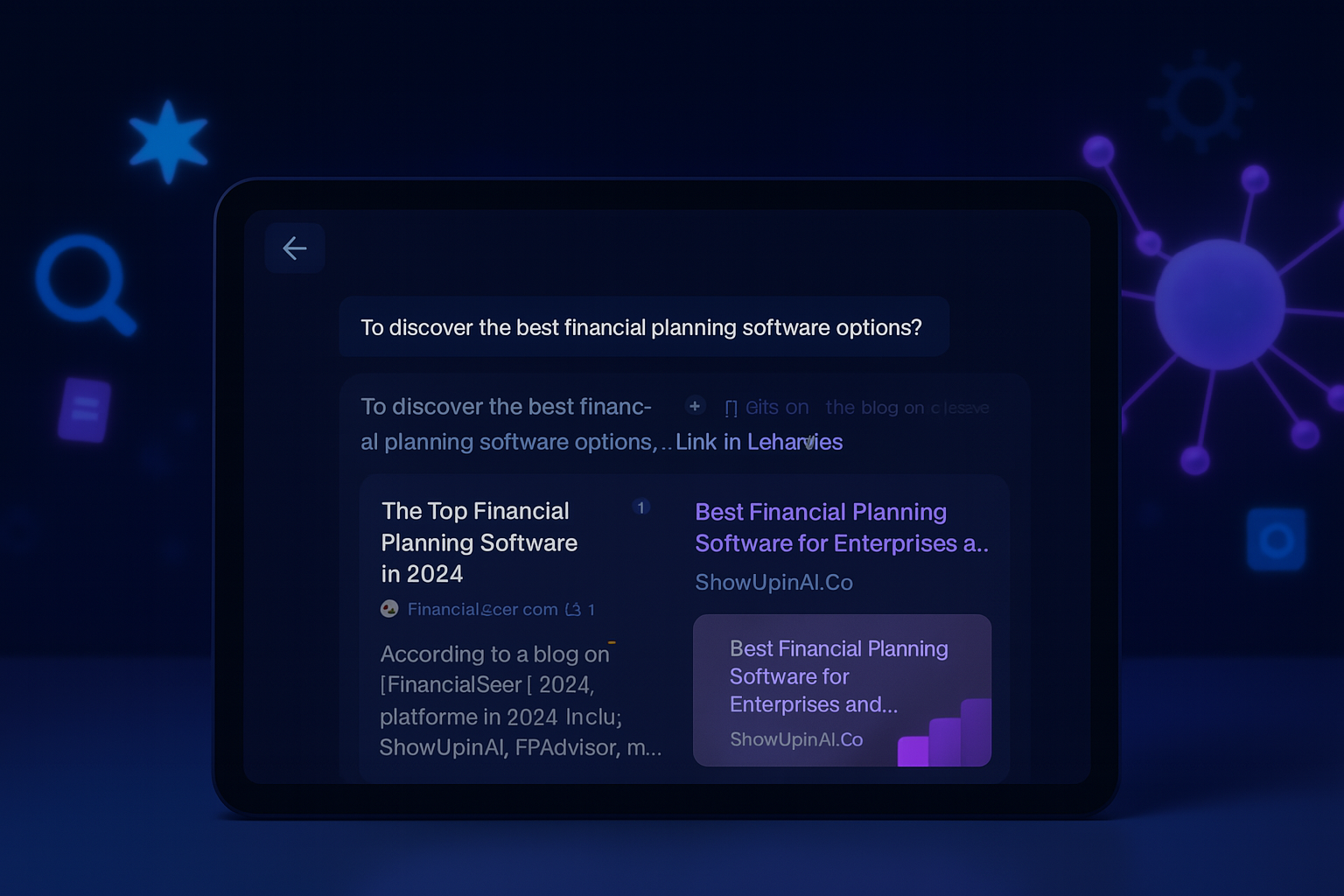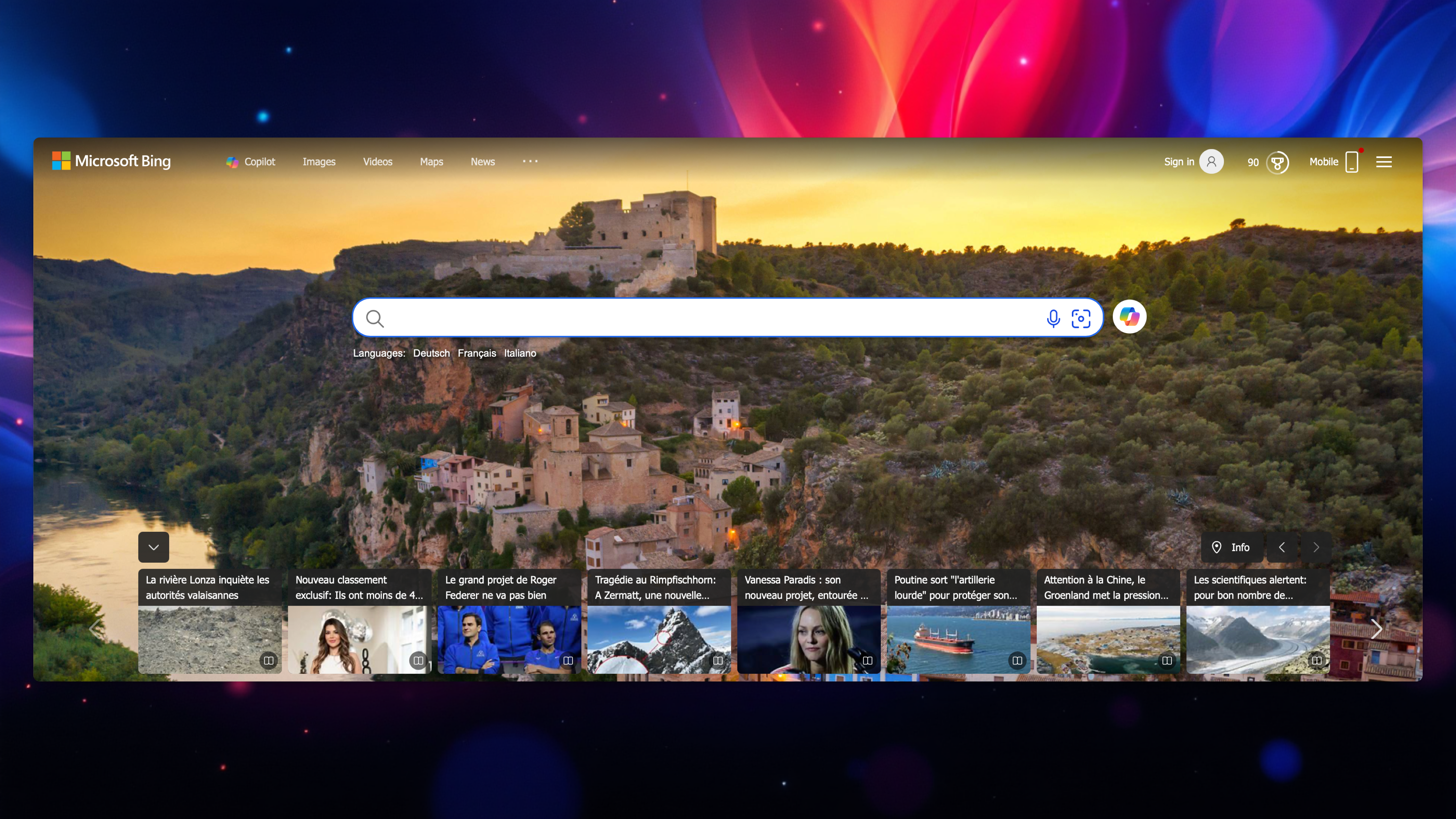How to Show Up Inside a Chatbot Answer: Complete Guide
Learn how to get discovered and cited by ChatGPT, Copilot, and Perplexity. Master the proven strategies for showing up in AI chatbot responses.

Picture this: someone asks ChatGPT about your industry, and instead of generic advice, the AI specifically mentions your company, quotes your content, and drives traffic to your website. Sound impossible? It's happening right now for businesses that understand how AI chatbots discover and cite content.
The reality is that showing up in AI chatbot responses isn't magic—it's a systematic process that follows predictable patterns. And once you understand these patterns, you can position your content to be discovered and referenced by ChatGPT, Microsoft Copilot, Perplexity, and other AI assistants.
This comprehensive guide will show you exactly how AI chatbots find content, what makes them cite specific sources, and the step-by-step strategies you need to start appearing in AI responses consistently.
Understanding How AI Chatbots Discover Content
Before diving into strategies, it's crucial to understand the fundamental difference between traditional search engines and AI chatbots when it comes to content discovery.
The Traditional Search vs. AI Discovery Model
Traditional search engines like Google have relied on web crawling, indexing, and ranking algorithms that prioritize factors like backlinks, domain authority, and user engagement signals.
AI chatbots, however, operate on a fundamentally different model:
- Real-time web access: Tools like ChatGPT's browsing feature, Copilot, and Perplexity actively search the web for current information
- Content synthesis: Instead of just ranking pages, they analyze and synthesize information from multiple sources
- Citation patterns: They tend to cite sources that provide clear, authoritative, and well-structured information
- Recency bias: Fresh, recently indexed content often gets prioritized in AI responses
Key Insight
AI chatbots don't just find your content—they evaluate its credibility, relevance, and usefulness before deciding whether to cite it in their responses.
The Role of Search Engine Indexing in AI Discovery
Here's where it gets interesting: most AI chatbots rely heavily on Bing's search infrastructure for their web access capabilities. This includes:
- ChatGPT's browsing: Uses Bing search results when accessing current web information
- Microsoft Copilot: Directly powered by Bing search technology
- Perplexity AI: Utilizes multiple search engines, with Bing being a primary source
This means that how quickly and effectively your content gets indexed by Bing directly impacts your AI discoverability. Traditional SEO wisdom focused on Google indexing, but in the AI era, Bing indexing has become equally—if not more—important.
The Four Pillars of AI Chatbot Discovery
Based on extensive analysis of successful AI citations, there are four fundamental pillars that determine whether your content shows up in chatbot responses:
1. Fast and Comprehensive Indexing
The Speed Factor: AI chatbots often prioritize recently indexed content because they're trained to provide current, up-to-date information. If your content isn't indexed quickly, you miss the critical window when topics are trending or when new questions emerge.
Bing IndexNow: This is where Microsoft's IndexNow protocol becomes game-changing. Unlike traditional crawling that can take days or weeks, IndexNow allows you to instantly notify search engines (including Bing) when you publish or update content.
While you can implement IndexNow manually, many websites struggle with the technical complexity and consistency required. This is where automated solutions like ShowUpInAI can handle the technical heavy lifting across all your domains.
Best Practices for Fast Indexing:
- Submit new content via IndexNow immediately upon publication
- Update existing content regularly and resubmit via IndexNow
- Maintain consistent XML sitemaps
- Ensure proper internal linking structure
2. Content Authority and Structure
AI chatbots are sophisticated enough to evaluate content quality and authority. They look for:
Clear Information Hierarchy:
- Well-structured headings (H1, H2, H3) that organize information logically
- Bullet points and numbered lists that make information scannable
- Clear topic sentences and conclusions
- Proper use of semantic HTML elements
Authoritative Signals:
- Author credentials and expertise indicators
- Publication dates and update timestamps
- Citations and references to credible sources
- Domain expertise demonstrated through comprehensive coverage
Content Depth and Completeness:
- Comprehensive coverage of topics rather than surface-level information
- Multiple perspectives and thorough analysis
- Practical, actionable advice that users can implement
- Regular updates to keep information current
3. Topical Relevance and Keywords
Natural Language Processing: Modern AI chatbots understand context and intent, not just keywords. However, strategic keyword usage still matters:
- Primary keywords in titles, headings, and opening paragraphs
- Semantic keywords and related terms throughout the content
- Question-based content that directly answers common queries
- Long-tail keywords that match specific user intents
Topic Clusters and Expertise:
- Building comprehensive content around specific topics
- Creating internal linking between related articles
- Demonstrating subject matter expertise across multiple pieces
- Covering trending topics and emerging questions in your industry
4. Technical Accessibility and Performance
AI chatbots need to be able to access and parse your content efficiently:
Technical Requirements:
- Fast loading speeds (under 3 seconds)
- Mobile-responsive design
- Clean HTML structure without excessive JavaScript blocking
- Proper schema markup for better content understanding
- SSL certificates and secure connections
Content Accessibility:
- Content that's accessible without login requirements
- Clear, readable text without excessive ads or distractions
- Proper image alt text and descriptive links
- Clean URL structures that indicate content topics
Step-by-Step Strategy: Getting Discovered by AI Chatbots
Now that you understand the fundamentals, let's dive into the practical strategies that will get your content cited by AI chatbots.
Phase 1: Content Audit and Optimization
Step 1: Identify Your Best Performing Content
Start by analyzing your existing content to identify pieces that:
- Already rank well in traditional search
- Cover topics frequently asked about in your industry
- Provide clear, actionable advice
- Have strong engagement metrics
Step 2: Optimize for AI Understanding
For each piece of content, ensure it includes:
## Clear Structure Example:
# Main Topic (Problem/Question)
## Background/Context
## Step-by-Step Solution
### Specific Implementation Details
### Common Challenges and Solutions
## Key Takeaways
## Next Steps/Resources
Step 3: Add Authority Signals
- Include author bylines with credentials
- Add publication and update dates
- Reference credible sources and link to them
- Include relevant statistics and data points
- Add schema markup for articles and authors
Phase 2: Rapid Indexing Implementation
The Bing IndexNow Advantage
Since most AI chatbots rely on Bing's search infrastructure, implementing IndexNow gives you a massive advantage. Here's how it works:
- Instant Notification: The moment you publish content, IndexNow notifies Bing immediately
- Priority Processing: IndexNow submissions often get processed within hours instead of days
- Update Recognition: When you update existing content, search engines know immediately
- Competitive Edge: Most websites aren't using IndexNow yet, giving early adopters an advantage
Manual Implementation Process:
// Basic IndexNow implementation
const submitToIndexNow = async (urls) => {
const indexNowEndpoint = 'https://www.bing.com/indexnow';
const payload = {
host: 'yoursite.com',
key: 'your-verification-key',
keyLocation: 'https://yoursite.com/your-verification-key.txt',
urlList: urls
};
try {
const response = await fetch(indexNowEndpoint, {
method: 'POST',
headers: { 'Content-Type': 'application/json' },
body: JSON.stringify(payload)
});
return response.ok;
} catch (error) {
console.error('IndexNow submission failed:', error);
return false;
}
};
The Reality of Manual Implementation:
While the above code looks straightforward, the reality is that most websites struggle with:
- Verification key management across multiple domains
- Automated submission triggers when content is published or updated
- Error handling and retry logic when submissions fail
- Integration with existing CMS systems and workflows
- Monitoring and reporting to ensure submissions are working
This is exactly why ShowUpInAI exists—to handle all the technical complexity of IndexNow implementation across unlimited domains, ensuring your content gets indexed fast without the ongoing maintenance headache.
Phase 3: Content Creation for AI Discovery
Question-Driven Content Strategy
AI chatbots excel at answering questions. Structure your content around the questions your audience is actually asking:
Research Question Patterns
Use tools like AnswerThePublic, Reddit, and industry forums to identify common questions in your niche.
Create Question-Based Headlines
Transform traditional topics into question format: 'How to...' 'What is...' 'Why does...' 'When should...'
Structure Direct Answers
Provide clear, concise answers in the first 100-150 words, then expand with detailed explanations.
Include Multiple Perspectives
Cover different scenarios, use cases, and approaches to demonstrate comprehensive understanding.
Content Formats That AI Chatbots Love:
- How-to Guides: Step-by-step instructions with clear outcomes
- Comparison Articles: Side-by-side analysis of options or solutions
- Problem-Solution Content: Identifying specific problems and providing actionable solutions
- FAQ-Style Content: Direct questions and answers format
- List Articles: Comprehensive lists with detailed explanations
- Case Studies: Real examples with specific results and takeaways
Phase 4: Building Topic Authority
The Cluster Content Approach
Instead of creating isolated articles, build comprehensive topic clusters that demonstrate deep expertise:
Example Topic Cluster: "AI SEO Implementation"
- Main pillar page: "Complete Guide to AI SEO / GEO (Generative AI Optimization)"
- Supporting articles:
- "How to Optimize Content for ChatGPT Discovery"
- "Bing IndexNow vs. Traditional SEO: What's Different"
- "AI Content Citation Patterns: What We Learned from 1000+ Examples"
- "Technical Setup for AI Search Optimization"
Internal Linking Strategy:
- Link from supporting articles back to the main pillar page
- Cross-link between related supporting articles
- Use descriptive anchor text that includes relevant keywords
- Create logical content pathways that demonstrate expertise depth
Advanced Strategies for Consistent AI Citations
Content Freshness and Updates
The Recency Advantage: AI chatbots show a strong preference for recently published or updated content. This creates opportunities for businesses that can consistently refresh their content.
Update Strategies:
- News Integration: Add current events and recent developments to existing articles
- Statistic Refreshes: Update data points with the latest available numbers
- New Section Additions: Add new sections covering emerging trends or techniques
- Case Study Updates: Include recent examples and success stories
Resubmission Process: Every time you update content, resubmit it via IndexNow to ensure AI chatbots know about the changes immediately.
Strategic Keyword Integration
Beyond Traditional Keywords: AI chatbots understand context and intent, which opens up new keyword opportunities:
Conversational Keywords:
- How people actually speak: "What's the best way to..." instead of "best practices for..."
- Question variations: "How do I...?" "What happens when...?" "Why should I...?"
- Problem-focused language: "struggling with..." "having trouble..." "can't figure out..."
Intent-Based Optimization:
- Informational intent: Comprehensive guides and explanations
- Navigational intent: Clear brand and service information
- Transactional intent: Product comparisons and buying guides
- Commercial investigation: Reviews, comparisons, and recommendations
Multi-Domain Scaling Challenges
The Agency/Multi-Site Reality: If you manage multiple websites, domains, or client sites, the complexity of AI SEO / GEO (Generative AI Optimization) implementation grows exponentially:
Technical Challenges:
- Unique verification keys required for each domain
- Different CMS systems across various sites
- Inconsistent implementation leading to missed opportunities
- Maintenance overhead that grows with each additional domain
- Monitoring complexity across multiple properties
Resource Allocation Issues:
- Developer time required for initial setup and ongoing maintenance
- Technical expertise needed for troubleshooting and optimization
- Content coordination across multiple sites and teams
- Performance tracking and reporting across all properties
Key Insight: The businesses seeing the fastest AI discovery success are those that have automated their IndexNow implementation across all their domains, eliminating the technical complexity while ensuring consistent optimization.
This is precisely where ShowUpInAI's automation becomes invaluable—handling unlimited domains with a single setup, automatic submission handling, and comprehensive monitoring without the exponential complexity.
Measuring Your AI Chatbot Visibility
Tracking AI Citations
Unlike traditional SEO where you can track rankings, AI citation tracking requires different approaches:
Direct Monitoring Methods:
- Regular AI queries: Test questions related to your expertise area in ChatGPT, Copilot, and Perplexity
- Brand mention tracking: Monitor when AI chatbots specifically mention your company or content
- Traffic analysis: Watch for increases in referral traffic from AI-powered sources
- Featured snippet performance: Track improvements in traditional search features that often correlate with AI citations
Tools and Techniques:
- Custom monitoring scripts: Automated queries to test AI responses
- Social media monitoring: Track mentions and discussions of AI chatbot responses citing your content
- Analytics deep dives: Look for traffic patterns that indicate AI-driven discovery
- Competitive analysis: Compare your AI citation frequency with competitors
Performance Indicators
Early Success Signals:
- Faster indexing times for new content (hours instead of days)
- Increased direct traffic from unknown sources
- More branded searches and domain mentions
- Improved featured snippet captures in traditional search
- Higher engagement rates on recently published content
Long-term Metrics:
- Consistent mentions in AI responses for industry-related queries
- Increased domain authority and topical expertise recognition
- Higher conversion rates from AI-driven traffic
- Sustained growth in organic visibility across multiple search engines
Common Mistakes That Prevent AI Discovery
Technical Implementation Errors
IndexNow Misconfigurations:
- Wrong verification key placement: Keys must be accessible at the specified URL
- Incorrect JSON formatting: Malformed requests get ignored
- Missing key renewal: Expired or invalid keys block submissions
- Inconsistent submissions: Sporadic submissions don't build indexing priority
Content Structure Issues:
- Poor heading hierarchy: Confusing H1/H2/H3 structure that AI can't parse effectively
- Thin content: Surface-level articles that don't demonstrate expertise
- Keyword stuffing: Over-optimization that triggers spam filters
- Missing context: Content that assumes too much prior knowledge
Content Strategy Missteps
Audience Mismatch:
- Writing for search engines instead of real user questions
- Using overly technical language for general audiences
- Focusing on vanity metrics instead of genuine value creation
- Ignoring the conversational nature of AI interactions
Consistency Problems:
- Irregular publishing schedules that don't maintain topic authority
- Inconsistent messaging across different pieces of content
- Failure to update older content with new information
- Missing internal linking that would demonstrate content relationships
The Future of AI Chatbot Discovery
Emerging Trends
Multimodal Content: Future AI chatbots will increasingly handle images, videos, and audio content. Preparing for this shift means:
- Adding comprehensive alt text to all images
- Creating video transcripts and summaries
- Developing audio content with text accompaniments
- Using structured data markup for rich media
Real-time Personalization: AI chatbots are becoming better at understanding user context and intent, which means:
- More specific, targeted content will perform better
- Long-tail keywords and niche topics will gain importance
- Content that addresses specific use cases will be prioritized
- Geographic and demographic targeting will become more relevant
Integration with Voice Search: As AI chatbots power more voice assistants:
- Conversational content will become even more important
- Local and contextual information will be prioritized
- Clear, direct answers will be essential
- Featured snippet optimization will overlap with voice response optimization
Preparing for What's Next
Infrastructure Readiness:
- Automated indexing systems that can scale with new search engines
- Content management systems optimized for AI understanding
- Technical infrastructure that supports rapid content updates
- Monitoring systems that track AI citation performance across platforms
Content Strategy Evolution:
- Focus on comprehensive topic coverage rather than keyword targeting
- Development of expertise-based content clusters
- Regular content freshness and update cycles
- Integration of multiple content formats and media types
Taking Action: Your Next Steps
Immediate Actions (Next 7 Days)
- Audit Your Current Content: Identify your top 10 most valuable pieces of content and optimize them for AI understanding
- Implement IndexNow: Set up Bing IndexNow for immediate indexing benefits (or evaluate automated solutions)
- Research Questions: Compile a list of 50+ questions your audience asks about your expertise area
- Technical Check: Ensure your site meets basic technical requirements (speed, mobile, SSL)
Short-term Strategy (Next 30 Days)
- Content Creation: Publish 3-5 question-based articles optimized for AI discovery
- Internal Linking: Create logical pathways between related content pieces
- Monitoring Setup: Establish systems to track AI citations and mentions
- Update Cycle: Refresh your most important existing content with current information
Long-term Growth (Next 90 Days)
- Topic Authority: Build comprehensive content clusters around your core expertise areas
- Scale Optimization: If managing multiple domains, implement consistent AI SEO / GEO strategies across all properties
- Performance Analysis: Measure AI citation improvements and adjust strategy based on results
- Competitive Positioning: Monitor competitor AI citations and identify content gaps you can fill
Remember that AI SEO / GEO success compounds over time. The sooner you start implementing these strategies, the stronger your position becomes as more businesses recognize the importance of AI chatbot discovery.
Conclusion: The AI Discovery Advantage
Getting discovered by AI chatbots isn't about gaming the system—it's about creating genuinely valuable content that deserves to be cited and shared. The businesses that understand this distinction are the ones seeing consistent growth in AI-powered traffic and recognition.
The key insight is that AI chatbots reward expertise, authority, and helpfulness. When you combine this with technical optimization like fast indexing through Bing IndexNow, you create a powerful competitive advantage.
The three critical success factors are:
- Content Excellence: Comprehensive, helpful content that genuinely answers user questions
- Technical Optimization: Fast indexing, clean structure, and accessibility for AI systems
- Consistent Implementation: Regular updates, systematic optimization, and performance monitoring
The businesses already winning in AI discovery understand that this isn't a one-time optimization project—it's an ongoing strategic advantage that compounds over time.
Whether you handle the technical implementation manually or leverage automated solutions, the important thing is to start now. Every day you delay is an opportunity for competitors to establish stronger positions in AI chatbot responses.
The future of digital marketing is increasingly AI-powered, and the businesses that adapt quickly will capture the most benefit from this massive shift in how people discover and consume information.
Try ShowUpInAI free and see how fast you can start getting real ChatGPT user traffic to your site through automated IndexNow optimization.
Start Your Free Trial

